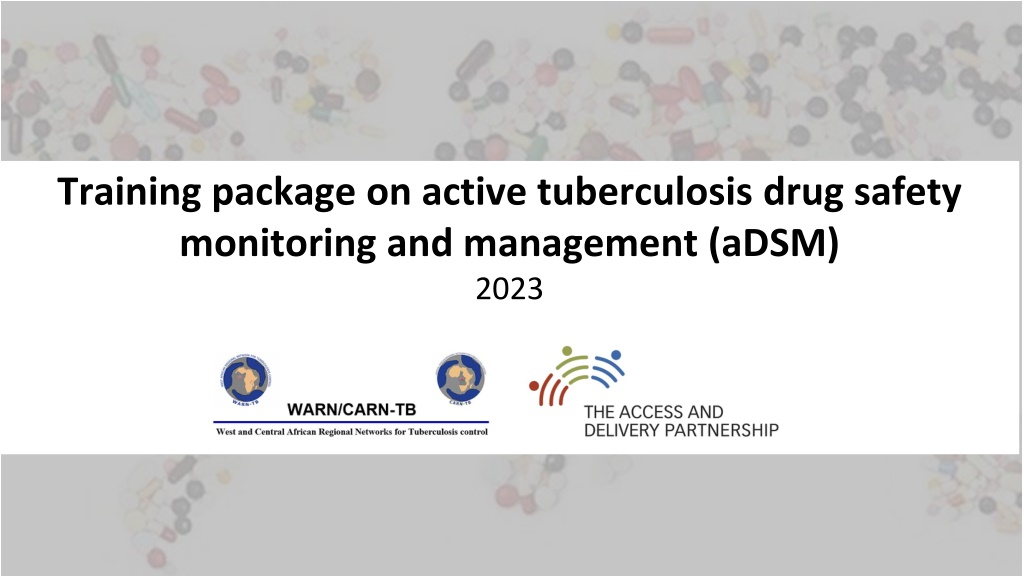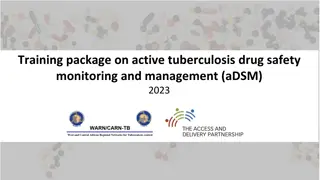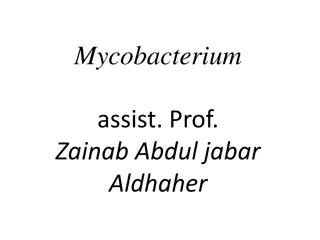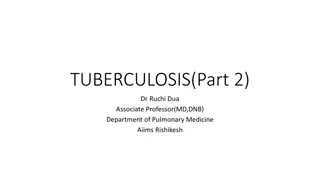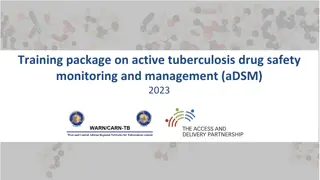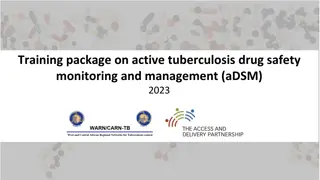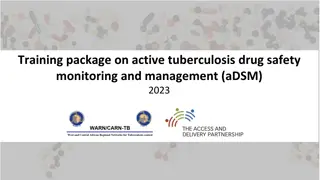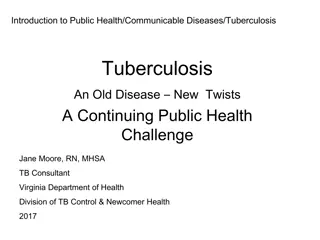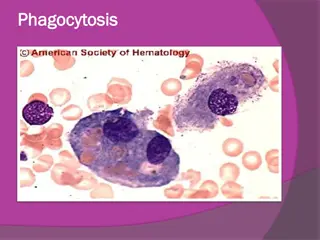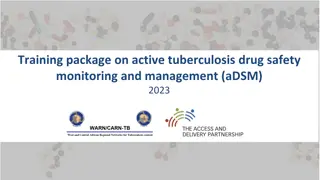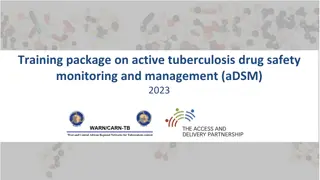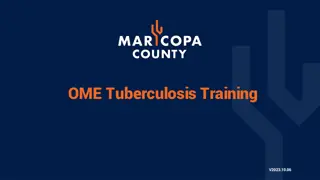Comprehensive Guide on Active Tuberculosis Drug Safety Monitoring and Management (aDSM) Implementation
This comprehensive guide provides key steps and timelines for implementing Active Tuberculosis Drug Safety Monitoring and Management (aDSM). It covers the development of a plan, defining roles and responsibilities, data collection, training, and electronic data consolidation. The timeline includes activities such as establishing a national coordinating mechanism, developing an implementation plan, training staff, and implementing aDSM. Detailed sub-tasks and timelines are provided for each step to ensure successful implementation at the country level.
Download Presentation

Please find below an Image/Link to download the presentation.
The content on the website is provided AS IS for your information and personal use only. It may not be sold, licensed, or shared on other websites without obtaining consent from the author. Download presentation by click this link. If you encounter any issues during the download, it is possible that the publisher has removed the file from their server.
E N D
Presentation Transcript
Training package on active tuberculosis drug safety monitoring and management (aDSM) 2023
Key steps in aDSM implementation Create a national coordinating mechanism for aDSM Develop a plan for aDSM Define management and supervision roles and responsibilities Create standard data collection materials Train staff on the collection of data Define schedules and routes for data collection and reporting Consolidate aDSM data electronically Develop capacity for signal detection and causality assessment
Learning objective By the end of this presentation, the participant is expected to be able to: Explain the main activities and timelines needed in an implementation plan for aDSM at country level
Timeline for aDSM implementation (1) An example GANTT chart showing timelines for all activities needed in preparation for aDSM for the programmatic introduction of new drugs or regimens is shown on the following slide Each activity listed in the chart will need to be costed and matching resources identified Sub-activities also need to be developed; more detail available in other slide sets in this module
Timeline for aDSM implementation (2) Months before start START Activities 6 5 4 3 2 1 0 Establish national coordinating mechanism for aDSM Develop aDSM implementation plan Decide on paper or electronic system to be used for aDSM data collection Training on aDSM (for national PV centre, for clinicians/nurses, for data- entry staff, etc.) Define roles and responsibilities at each NTP level, and between NTP and national PV centre Develop work plan and budget Define the local list of data elements and data dictionary Include aDSM data elements in MDR-TB care data collection tools Adjust data monitoring and evaluation system Develop data management plan Develop standard operating procedure (SOP) Pilot data collection and processing up to national level Implement aDSM
Establish a national coordinating mechanism for aDSM Time for completion Two months Start six months prior to aDSM implementation Sub-tasks Include representatives from the NTP, the national PV center, and MDR-TB clinical experts from facilities Develop terms of reference for the committee Refer to Module 2.1i (Create a national coordinating mechanism for aDSM)
Develop aDSM implementation plan Time for completion Three months Start six months prior to aDSM implementation Sub-tasks Make and document decisions about what needs to be done who does what, when, and where Steps described in the following slides will help plan for a successful strategy
Decide on paper or electronic system for aDSM data collection This activity is a relative priority given that the collection of data is key Time for completion Two months Start six months prior to aDSM implementation Sub-tasks NTPs that manage programme data using electronic systems with data quality assurance processes in place may be able to obtain aDSM data collected regularly electronically Ensure aDSM can be integrated into routine system used for MDR-TB surveillance
Conduct aDSM Training This activity is a relative priority to ensure that the collection of data (in prior slide) proceeds well Time for completion One month Start two months prior to aDSM implementation Sub-tasks Define staff to be trained Plan post-implementation new staff training Plan post-implementation refresher trainings Refer to other relevant modules in this series, especially module 2.1v for data collection training and module 2.1viii for capacity building
Develop Work Plan and Budget Time for completion Two months Start five months prior to aDSM implementation Sub-tasks Analyze each for resource requirements. Estimate cost of supplies, travel, and time needed by employees Conduct a feasibility check to see if staff will actually have time available to do the work Refer to Module 3.5 for partner contributions
Define roles and responsibilities Time for completion Two months Start five months prior to aDSM implementation Sub-tasks Refer to module 2.1iii (Management, supervision and roles and responsibilities) and and 2.1viii (Capacity building)
Define the local list of data elements and data dictionary Time for completion Two months Start five months prior to aDSM implementation Sub-tasks Decide on a coding dictionary, and grading scales to be used nationally National Cancer Institute Common Terminology Criteria for Adverse Events (NCI- CTCAE) Division of Microbiology and Infectious Diseases (DMID) Adult Toxicity Table
Include aDSM data elements in MDR-TB care data collection tools Time for completion One month Start three months prior to aDSM implementation Sub-tasks Update AE and SAE forms Update standard treatment forms Refer to Modules 2.1iv (Create standard data collection materials) and 2.1.vii (Consolidate aDSM data electronically)
Adjust monitoring and evaluation system to incorporate aDSM Time for completion One month Start three months prior to aDSM implementation Sub-tasks Conduct a feasibility check Pilot adjustments Revise adjustments if appropriate Refer to modules 2.1iv and 2.1vii in this series
Develop data management plan Time for completion Two months Start four months prior to aDSM implementation Sub-tasks Ensure processes and procedures are in place for: storing processing Validating and archiving of data collecting monitoring handling storing
Develop SOP Time for completion Two months Start three months prior to aDSM implementation Sub-tasks Adjust existing SOP Ensure every SOP includes: Introduction of the procedure For which staff members it is applicable Step-by-step description of the procedure Frequency and/or specific timing Expected results/outcomes
Pilot data collection and processing up to national level Time for completion One month Start one month prior to aDSM implementation Sub-tasks Adjust technical system (if needed) Adjust and retest at national level Adjust SOPs (if needed)
Conclusions The aDSM plan needs to try and describe the different components which need to come together in order for aDSM to be successfully completed over a reasonable period of time (e.g. 6 months) The plan needs to identify appropriate domestic and external funding which can be brought together in order to make aDSM a reality The critical steps will be to establish : a national coordinating mechanism; roles and responsibilities of different national actors; recording and reporting parameters; data management (electronic); and to train staff on aDSM
Acknowledgements The development of the aDSM training material was funded by TDR as part of the Access and Delivery Partnership (ADP) with funding from the Government of Japan. These training materials were put together in 2016 the WHO Task Force on aDSM with technical partners KNCV Tuberculosis Foundation, Management Sciences for Health (SIAPS), MSF, WHO GTB, and TDR. The materials were updated in 2022-23 by Mahamadou Bassirou Souleymane (TDR consultant) with Marie-Eve Raguenaud (TDR), Branwen J Hennig (TDR), and Corinne Merle (TDR), and reviewed by Linh Nhat Nguyen (WHO/GTB), Medea Gegia (WHO/GTB), and Fuad Mirzayev (WHO/GTB). We thank all members of the WARN/CARN-TB working group on aDSM who contributed to the development of the aDSM generic guidelines as well as the secretariat, particularly Dr Christ Houessinon: Disadidi Ambrioso, Esse Marius, Adomou Jamal Rouamba Ruffine, Haro Sougrimani, Koumbem Boureima, Nsanzerugeze Jos lyne, Tollo Tollo Daniel Alphonse D sir , Mpaba Minkat Th ophile Mistral, Julie Abessolo, Ursule IDOKO, Tijan Baldeh , Wandifa Samateh, Tida S Kinteh, Alieu Wurie, Mardemn Yeasuen, Benjamin K. Quenneh, Cheick Oumar Bah, Kane El Hadj Malick, Aw Idriss, Mamoudou Hama Rachida, Gagara I. M. Assiatou, Katamb Balkissa, Seiyabatou ElhSaidou, Liombo Anastasie, Lunganyu Junior, Kitambala Sentime, Lula Yves , Habimana-Mucyo Yves, Migambi Patrick, dos Santos Brigite, Castro V nia, Wadson Cruz, Gueye Aminata, Mukeh Fahnbulleh, Bailor Samuel, Manjo Lamin, Saleh Mahareb Abdoulaye, Haroun Saleh Naima, Mouhoudine Yerima, Kpelafia Silifa
